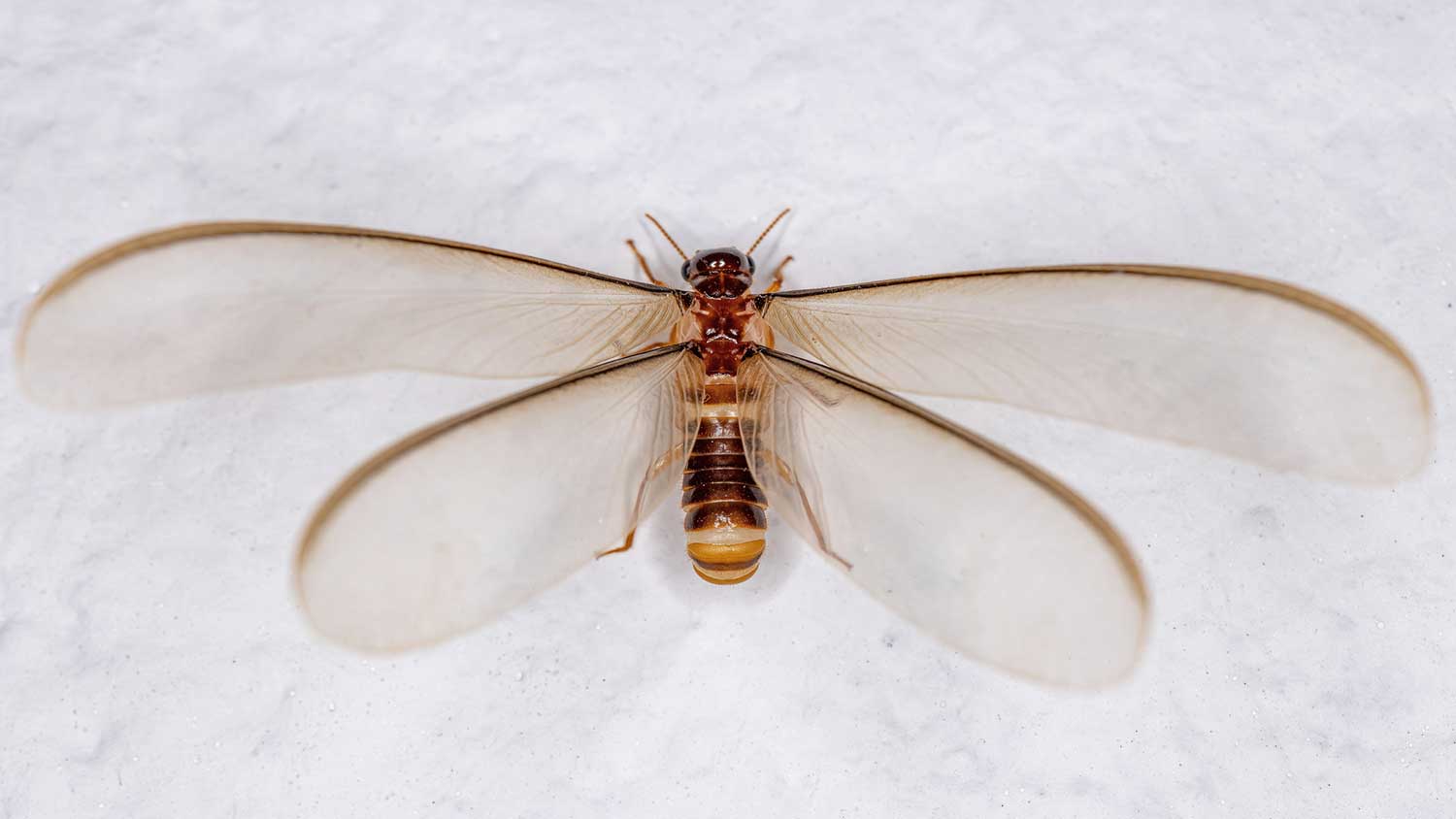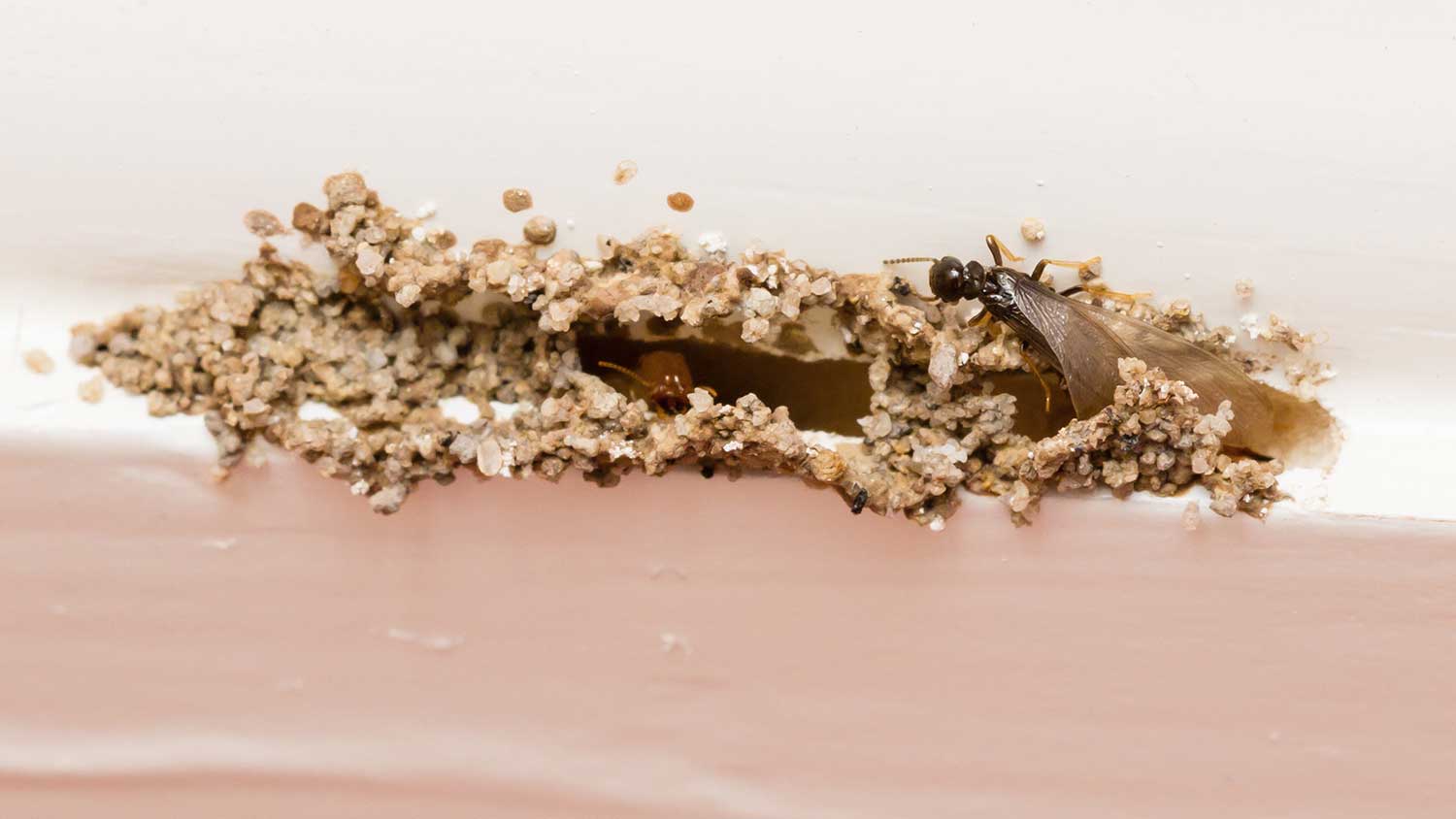Flying Ants vs. Termites: What’s The Difference?
Learn to identify the winged intruders around your home


Highlights
Termites have wide, straight bodies, while flying ants have pinched waists.
Termites have straight antennae, while the flying ant’s are elbow-shaped.
Termites have two sets of same-size wings, while flying ants have a noticeable size difference between their front and hind wings.
Both flying ants and termites nest in wood, but termites also eat it and can cause serious damage if left untreated.
In the world of flying insects, there’s an often-mistaken identity that can cause confusion and concern: Flying carpenter ants vs. termites. The presence of either of these winged invaders is enough to send your anxiety through the roof, leaving you wondering if you are dealing with an ant problem, or something far more serious—termites.
By understanding their distinct features, you can easily identify these pests and take immediate action to protect your home and property. Here are the key differences between flying ants and termites.
| Type of Difference | Flying Ants | Termites |
|---|---|---|
| Size | ¾ inch | ¼–½ inch |
| Color | Black, brown, red | Red, brown, light yellow, tan |
| Number of Legs | 6 legs | 6 legs |
| Host Preference | Decaying wood | Wood |
| Habitat | Near moisture and moist wood | Dark, damp areas |
| Disease | Does not carry disease | Does not carry disease |
Flying Ants vs. Termites: Differences in Appearance

Flying ants and termites share some similar characteristics, but they have distinct differences in their appearance.
Size
Flying ants and termites are relatively small pests, making it difficult to get close enough to distinguish between them. However, termites range from ¼ to ½ inch long, while flying ants reach ¾ inch long.
Color
Flying ants can have black, brown, or red bodies, with two pairs of brown-colored wings. On the other hand, termite coloring depends on the species type. Drywood termites are typically red or brown, but dampwood termites are usually lighter shades of tan or yellow.
Shape
Termites can be recognized by their straight antennae, wide bodies, and two pairs of wings that are approximately the same size. If the bugs you’re seeing fit this description, it’s urgent to get a termite inspection ASAP.
On the other hand, flying ants have a pinched waist and beaded elbow-shaped antennae. Unlike termites, there is a noticeable size difference between their front and hind wings.
Feeding Differences
Flying ants have a diverse diet that includes seeds, nectar, food scraps, and other insects around the home. In contrast, termites prefer chewing on cellulose fibers that are found in various sources such as wood, plants, paper, and cardboard. Many types of termite treatment involve treating the affected wood to kill off existing termites and prevent new ones from moving in.
Habitat Differences
Flying ants can be found in open areas, though they make their nests by tunneling into wood. They typically nest in wood that is wet, damp, or in a state of decay. Although not nearly as common, they can inhabit dry wood as well. Termites also build their nests in wood, but you’ll rarely see them out in the open as you would with flying ants.
Swarming Behavior
Both flying ants and termites exhibit swarming behavior, which can cause confusion between the two. Termite swarms typically happen during daylight hours, often in the spring season and after a rainstorm (although termite colonies remain active throughout the year).
Flying ants have a much shorter swarming period, which only takes place during warmer weather. Although it’s sometimes called “flying ant day,” the process typically happens over a few weeks, often having several peaks that span over a few days.
Damage Differences

A major difference between flying ants vs. termites is the damage they cause. Termites feed on the wooden components of homes and can do serious structural damage if left untreated; this is why it’s urgent to take the proper steps to get rid of termites as soon as you suspect an infestation. Flying ants tunnel into wood and can cause damage as well, though they don’t eat the wood and are generally less destructive.
Aside from identifying the bugs, there are several other signs that can point to an infestation. For flying ants, you might see a trail of ants leading to your home or small wood shavings near where they have burrowed. Termites leave behind more noticeable damage, such as wood that sounds hollow when you knock, peeling or faded paint, and buckling laminate or hardwood floorboards.
Treatment Differences
Now that we understand the differences between these unwanted pests, let’s review how to get rid of them.
How to Treat Flying Ants
You can usually subdue flying ants by sucking up visible ones with a handheld vacuum. Commercial insecticides are also an option, but be advised that these are toxic to humans and pets and should only be used with extreme caution.
The surefire way to get rid of ants in your home is to hire an ant exterminator. Professional ant treatment costs range from $80 to $500, depending on the ant type and infestation severity. When getting quotes from local pest control companies, ensure they specialize in flying ant removal methods.
How to Treat Termites
In cases of termite infestation, it’s highly advisable to skip the DIY and invest in the professional termite treatment, which typically costs between $250 and $1,000. The project cost of termite extermination will depend on treatment type, with termite fumigation and chemical termiticide costing the most and termite baiting and tenting the least. The average cost for termite removal ranges from $3 to $20 per linear foot.
A local termite exterminator has access to the most potent and fast-acting treatments available. If you want to banish these winged intruders, get in touch with a pro today to protect your home and restore your peace of mind.
Prevention Differences
Follow these tips to prevent termites and flying ants from returning to your home.
Preventing Flying Ants
Cut back plants and branches that come in contact with your home
Store firewood far away from the home
Address moisture issues as soon as possible, as these can weaken or rot your wood
Eliminate food sources by properly storing food
Seal cracks around windows and baseboards
Inspect and repair rotting wood
Preventing Termites
Seal cracks around water and gas lines
Install bug screens around attic vents and foundation
Install a dehumidifier in crawl space
Repair leaky AC units and plumbing immediately
Remove rotting wood, dead trees, tree stumps
Use termite-resistant mulch in yard
Frequently Asked Questions
Not necessarily. If you see a swarm of flying insects, it could be flying ants or termites, but not always both. However, since these winged pests are attracted to moist and rotting wood, there’s a chance that both species are present at the same time.
If flying ants have taken up residence in your home, they’re likely nesting near water leaks. Check for signs of flying ants near your bathtub, windows, doors, and sinks.
Unlike termites, flying ants won’t cause structural damage to your home. Plus, they won’t sting or bite you. However, they are a nuisance and unsanitary to keep in your home, so it’s best to hire a pest control company to remove the flying ants from your house.

